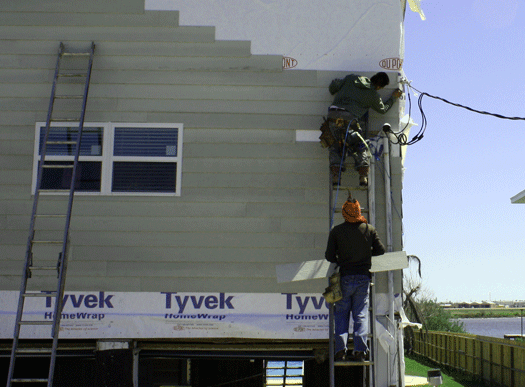Galveston’s gearing up for a big Memorial Day weekend celebration, and they’ve given it a name that reflects the resiliency of this island’s hardy inhabitants: Re-Birth Day.

It’s been only seven months since the third worst storm in the nation’s history walloped this small island city, leaving smelly water standing chest-high in the grand centenary Tremont Hotel, the colorful Victorian-style homes and the historic Strand district. Signs of the devastation are everywhere, from the blown-off front of a hotel to the leafless live oaks lining Seawall Boulevard.
Just this week, the National Trust for Historic Places named Galveston’s Historic Strand District one of America’s Most Endangered Places. It seems the cast iron frames supporting one of the largest historic commercial districts in the nation were already vulnerable due to the corrosive influence of the salty, humid air. The onslaught of Ike and the subsequent flooding of the area has placed the structures in imminent danger of collapse, according to the group’s preservation experts.
But just as surely are the signs of renewal: scaffolding and new siding going up on a beach house, a new fence around a newly rehabbed Victorian, a new cafe on the Strand, a new pier going up where The Balinese Room and Murdoch’s once jutted out into the Gulf. Fresh paint is everywhere; the painted ladies on Post Office Street practically jump up onto the sidewalk with their vivacious yellows and blues and pinks. And the beach, which had been scraped away by the force of the waves, is back; a beach reconstruction or “nourishment project” was completed along three quarters of the Gulf Coast before taking a break for the nesting season of the endangered Kemp’s ridley sea turtles who make their homes here.
RoShelle Gaskins, the city’s tourism coordinator, takes us on an upbeat city tour, starting us out along the Seawall. This 10.5-mile barrier is home to the nation’s largest sidewalk, she informs me. More importantly, it protects the city from the vicious wall of water that a hurricane can bring. It was built by the survivors of the devastating 1900 hurricane that nearly wiped Galveston off the map, and it saved the island from this one. That hurricane, which killed over 6,000 people, is still on the books as the worst natural disaster in the country’s history. But even as devastating a blow as that one couldn’t keep Galvestonians down. So it was a foregone conclusion that Ike wouldn’t, either.
“We love this place; we’re connected to it,” explained Gaskins. “We don’t mind having to pick ourselves up again. It’s just a part of life.”
Still, the storm’s impact weighs heavily on the city’s residents. And it hurts to consider how much less national attention Galveston has received than post-Katrina New Orleans, where church groups, volunteers and celebrities flocked to lend a hand. Some volunteers have come to help out with the rebuilding effort, but nothing on the scale of New Orleans. Former presidents Bill Clinton and George H.W. Bush have raised $2.2 million to help with the coastal recovery efforts since Ike, just a tiny fraction of the $130 million they raised after Katrina.
“People keep asking us, ‘Why don’t you call some celebrities?’ We have – but they don’t respond. They don’t want the burden of having to respond to every storm now.”
She’d had her hopes pinned on Houston native Beyonce, whose family hails from Galveston. But her sole benefit concert benefited only Houston.
There’s another factor, too, she added. The same week that Ike battered the Gulf coast, the nation’s first black candidate was chosen to lead the Democratic ticket, and the biggest bank bailout in the nation’s history took place.
Meanwhile, Galveston rolled up its sleeves and got to work. “We didn’t sit there and cry; we just got up and did what we had to do.”
Love your descriptions of the repairs going on. Beautifully written, and so sad.
The response to Katrina was an embarrassing display of social injustice in the United States, and I think that’s why it roused so many more well-wishers into action than Ike. Helping clean up New Orleans was a way for people to say, “not in my name” to the Bush administration, the Katrina victims and the world. Of course, once the lowlifes caught wind of the excitement, they showed up in droves too, hoping to further their tawdry careers or swindle money from the needy.
Tracy: This is an excellent report. Thanks for your care and integrity.
Lucy Burton
This is great Tracy. Thanks for the great writing–AND reporting.